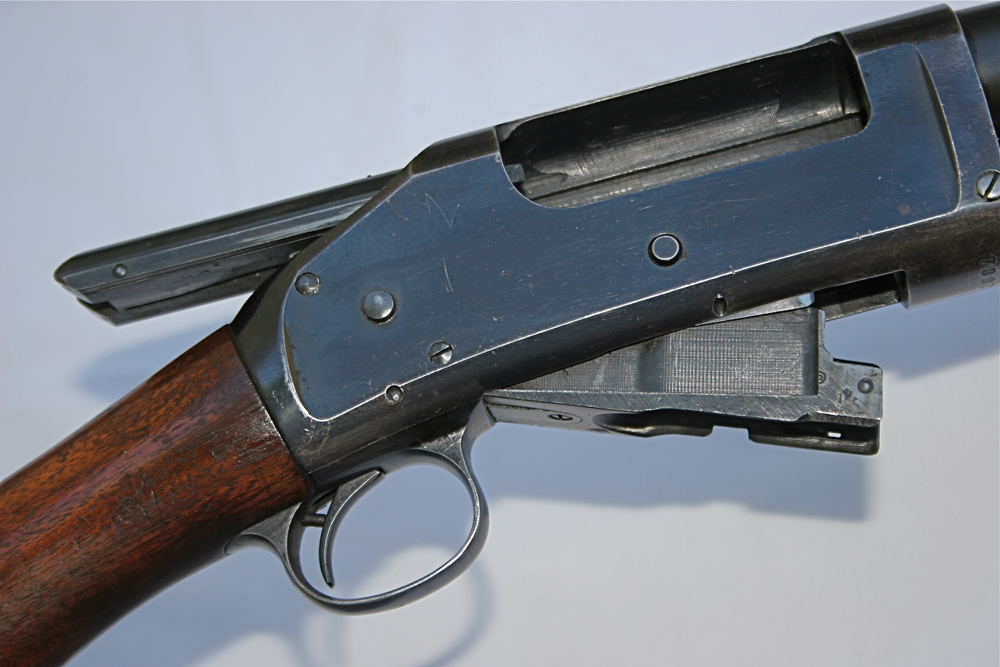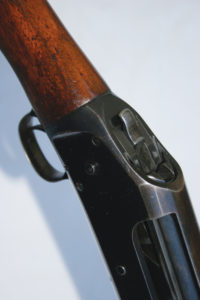

Whether brandished by Lee Marvin in The Professionals or wielded by William Holden in The Wild Bunch, the Winchester Model 97 Riot Gun is the bad boy of smoothbores.
Paradoxically, it was also a favorite of early 20th century law enforcement agencies, including the Texas Rangers, the Los Angeles Police Department, Alcatraz prison guards, and the Union Pacific Railroad, to name just a few of the authenticated guns I have examined over the years. In fact, a rather pristine Model 97 Riot Gun that I have in my collection was purchased by the Pasadena Police Department in 1924, during the heyday of the “Roarin’ ’20s.” It is nothing short of fascinating that, with all these historical links, one wouldn’t want to own one.
Because of its rugged yet fast-shooting action, the Model 97 Riot Gun is a favorite among Cowboy Action Shooters, and yet, due to those very attributes—its short, easy-to-swing 20-inch barrel, an Improved Cylinder open choke that makes it hard to miss in tight quarters, and an exposed hammer for easy cocking in times of stress—it's perfect for home-defense, as well. Still, it is hardly surprising that, in its standard 30-inch barreled configuration, the 12-gauge version of John Browning’s pump design was one of the most popular sporting shotguns in America around the turn of the last century. In more modern times, I remember rabbit hunting with a friend of a friend, many years ago, who was using his granddad’s old Model 97 riot gun as a brush clearing device with the first couple of shots, thereby exposing any cottontail stupid enough to still remain in the vicinity.

The Model 1897 was a much-needed evolution of Browning’s Model 1893, a weaker gun that was designed for blackpowder and, consequently, was plagued by fouling problems and a resultant poor reputation. It was one of Browning’s least successful inventions, bad enough to the point that, after approximately 31,000 guns had been sold, Winchester offered dealers a trade of any unsold Model 93 for a brand new Model 97. Fortunately, by the time Browning’s improved 1897 slide-action came on the scene, not only was it mechanically more proficient, but, by then, smokeless powder was in vogue and the new firearm’s metallurgy was ready for it.
With its solid-topped receiver and side ejection, the Model 1897 was a marked improvement over the Model 1893. In fact, the Model 97 stayed in the line until 1957, with 1,024,700 guns made. Initially chambered for the new 2¾-inch smokeless 12-gauge shells, the Winchester 97, like its 1893 predecessor, featured a tubular magazine that held five rounds. A forward movement of the automatic slide lock—usually recoil was enough—freed the pump handle for fast cycling of the action. First offered as a solid-frame model with a 30-inch barrel, a number of variations were eventually cataloged, including Field, Trap, and Pigeon Grades. However, the most dramatic of the Model 97’s configurations was the Riot Gun, which featured a 20-inch Cylinder-choked barrel. By 1898, a takedown version was also being produced. A note of warning: Riot Guns are so popular that many standard-length barrels have been cut down over the years, so, if buying the gun as an original or for investment, be sure the choke is marked CYL (Cylinder), the only authentic choke on a Riot Gun.

Another fascinating variation of the Model 97 Riot Gun is the Model 97 Trench Gun, which was given a military countenance via a distinctive, ventilated “heat shield.” Normally in a hunting situation, a sporting arm such as the standard Model 97 isn’t fired enough to become too hot to hold—in a wartime firefight, that 20-inch tube can become sizzling. To prevent scorched hands, a perforated steel heat shield was affixed to the barrel, along with a bayonet lug. This lug was meant for the standard military M-1917 bayonet, but the bayonet’s 16½-inch blade interfered with the otherwise excellent balance of the Trench Gun and was cumbersome in close quarters, especially during the trench warfare of WWI. The bayonet looked menacing when affixed to the Trench Gun, but it hampered movement and, obviously, was only useful in last-ditch operations. The sling swivels that were often fitted onto the Trench Gun, on the other hand, were much more practical. Early WWI guns were unmarked, but a “U.S.” and Army ordnance “flaming bomb” stamped on the receiver completed the identity for WWII guns that were called back into service.
Military loads often consisted of 00 buckshot, and an extra round in the chamber gave the Trench Gun a formidable capacity of six fast shots (in fact, sporting versions of the Model 97 were often advertised has having “six shots” even though their magazines only held five shells). Plus, the lack of a detent or trigger disconnect on the Model 97 meant a soldier could keep the trigger of his Trench Gun depressed and fire as fast as he could work the slide. The Trench Gun became so effective that it was soon nicknamed the “Trench Sweeper,” and soldiers who had been skilled trap and skeet shooters in civilian life often used their Model 97s to blast enemy hand grenades in mid-air before they landed. So devastating were these smoothbores that Germany tried unsuccessfully to get them outlawed from The Great War, declaring that “Every prisoner found to have in his possession such guns or ammunition belonging thereto forfeits his life.” Naturally, our troops continued to use their Trench Guns to blast their way to victory. And even though Trench Gun production was halted in 1945, this sawed-off shotgun continued to see action throughout Vietnam and the Gulf War.
Of course, the standard Model 97, including Riot Guns, remained in production for slightly more than a decade after that. When encountered today, most Trench Guns are quite worn, showing hard battlefield use, while the Riot Guns used by various police departments are usually in better shape, having spent much of their time in station gun racks and patrol cars. Whichever way, whether in civilian, law enforcement, or military dress, the Winchester Model 97 Trench and Riot Guns played important roles in keeping America not only safe, but free, which more than qualifies them to be included on my bucket list.
This article is an excerpt from 50 Famous Firearms You've Got to Own.
Learn More About Legendary Winchester
- 9 Greatest Winchester Rifles And Shotguns Ever Made
- Restored To Life: Winchester 1886
- Winchester Model 94: Receivers
- Winchester Model 12: The Perfect Pump-Action Shotgun

Next Step: Get your FREE Printable Target Pack
Enhance your shooting precision with our 62 MOA Targets, perfect for rifles and handguns. Crafted in collaboration with Storm Tactical for accuracy and versatility.
Subscribe to the Gun Digest email newsletter and get your downloadable target pack sent straight to your inbox. Stay updated with the latest firearms info in the industry.

![Best Concealed Carry Guns In 2025 [Field Tested] Wilson Combat EDC X9S 1](https://gundigest.com/wp-content/uploads/Wilson-Combat-EDC-X9S-1-324x160.jpg)


![Best 9mm Carbine: Affordable PCCs [Tested] Ruger Carbine Shooting](https://gundigest.com/wp-content/uploads/Ruger-Carbine-Shooting-100x70.jpg)
![Best AR-15: Top Options Available Today [Field Tested] Harrington and Richardson PSA XM177E2 feature](https://gundigest.com/wp-content/uploads/Harrington-and-Richardson-PSA-XM177E2-feature-100x70.jpg)
